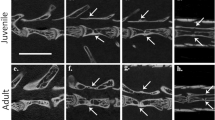Summary
The case of caudal abnormality described here is the first of its type and differs from all the previous records of such abnormalities in lizards-A complete account of its external appearance, scalation and skeleton is given, as well as some observations made on the musculature of the regenerated region. The author tries to interpret, as far as possible, how the growing tail must have been injured to produce such a peculiar abnormality. The cartiliginous tube is of a sinuous type and is peculiarly disposed, giving off a very small branch on the right side about the middle of its length.
Similar content being viewed by others
Literature Cited
Brindley, H. H. “On a specimen ofHemidactylus gleadovii Murray, with a bifid renewed tail,”Jour. Bomb. Nat. Hist. Soc., 1894,9, 30–33.
— “Some cases of caudal abnormality inMabuia carinata and other lizards,” —, 1898,11, 680–89.
Das, G. M. “Observations on the trifid tails in two specimens ofHemidactylus flaviviridis Rüppel, with a note on the artificial regeneration of double and triple tails of the ‘Tokhak’ lizard,Gecko verticillatus Laurenti.” —, 1932,35, Pt. 3, 657–62.
GiebelXeitschr. f. gestimmt. Naturwissenschaft. 1864.24, 18.
Hora, S. L. “Notes on lizards in the Indian Museum—1. On the Unnamed collection of Lizards of the family Gecko-nidæ,”Rec. Ind. Mus., 1926,28, 193.
Loveridge, H. “Notes on East-African lizards collected during 1915–19 with description of a new genus and species of Skink and a new sub-species of Gecko,”Proc. Zool. Soc., London, 1920,1, 133–34.
Loveridgu, II. “Notes on East-African lizards collected during 1920–23, with the description of two new cases ofAgama lionotus Blgr.,”ibem., 1923, 937–39.
Slotopolsky, B. “Beiträge zur Kenntnis des verstümnielungs-und Regenerationsvorgänge am Lacertilierschwanze,”Zool. Jahrb. Abt. f. Anat., 1921,43, 219–322.
Stuart, G. A. D. “Abnormal tail in a lizardHemidactylus gleadovii,”Jour. Bomb. Nat. Hist. Soc., 1908,18, 688–89.
Tornier, G. “Über experimentell erzeugte drieschwänzige Eidechsen und Doppelgliedmassen von Molchen,”Zool. Anzeig., 1897, Band20, 356.
Woodland, W. N. F. “Some observations on caudal autotomy and regeneration in the Gecko (Hemidactylus flaviviridis Klippel) with notes on the tails of Spenodon and I’ygopus,”Quart. Jour. Micr. Sci., 1920,65, Pt. I. 63–100.
Quelch “Tiinehri,”Jour. Roy. Agric. and Comm. Soc. of British Guiana, 1890,4, 148.
Author information
Authors and Affiliations
Additional information
Communicated by Mr. Beni Charan Mahendra,p.z.s.
Rights and permissions
About this article
Cite this article
Singh Sood, M. A peculiar case of caudal abnormality inhemidactylus flaviviridis rüppel. Proc. Indian Acad. Sci. 9, 316–322 (1939). https://doi.org/10.1007/BF03049633
Received:
Issue Date:
DOI: https://doi.org/10.1007/BF03049633




